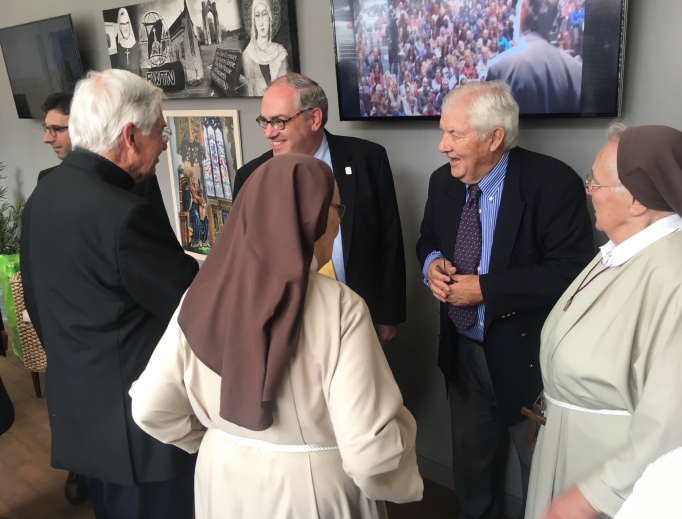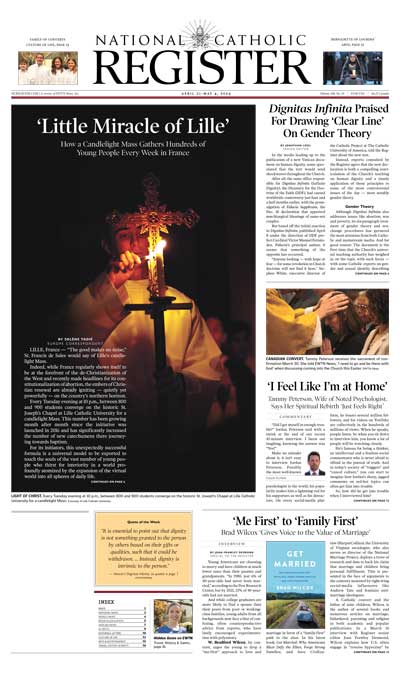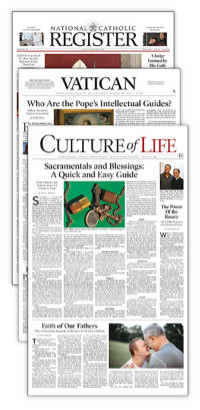EWTN Launches Studio Near Walsingham Shrine in England
EWTN Chairman and CEO Michael Warsaw officially opened the global network’s studio in Walsingham, England, Aug. 29.

NORWICH, England — EWTN opened its first studio and office in the United Kingdom near the Shrine of Our Lady of Walsingham Tuesday, emphasizing its role in supporting the Church’s evangelization in the region.
In an Aug. 29 statement on the studio launch, EWTN Chairman and CEO Michael Warsaw called the opening of the facility “a particularly important” step for the network’s continued development in the U.K.
The new studio, he said, “will allow us to greatly expand our capacity to produce programming for our European channels as well as to more easily incorporate content from the U.K. into our other channels around the world.”
He said it’s appropriate that the new studio is located just steps away from the Shrine of Our Lady of Walsingham, which annually draws hundreds of thousands of pilgrims from all over Britain and the world and which for centuries “has been one of the most important centers of Catholicism in Britain.”
With the shrine having such devoted pilgrims, Warsaw said he is “very happy that EWTN now has a presence in this extraordinary place and can share what happens here with our audience around the globe.”
Set in a converted house in the village of Walsingham, about 30 miles northwest of Norwich, the studio includes a street-level reception area and welcome center for visitors, where pilgrims can watch clips of EWTN’s most popular television shows, films and documentaries.

The Our Lady of Walsingham Shrine, one of the most important pilgrimage sites in Europe, dates to 1061. It is often referred to as “England’s Nazareth.” Both Anglican and Catholic chapels are located on-site, which has become a hub for ecumenical prayer and devotion.
Inspiration for the shrine came when a devout English noblewoman, Richeldis de Faverches, prayed to undertake a special task in honor of Our Lady.
According to tradition, in answer to the woman’s request, Mary appeared to her in a vision and took her to Nazareth, showing her where the Annunciation occurred. The Blessed Mother then asked De Faverches to build a replica of the house in Walsingham to serve as a perpetual memorial of that moment.
The shrine was built and a religious community put in charge of it. In 1150, a priory was built by the Augustinian Canons, and, eventually, Walsingham became one of the largest, most well-known shrines in medieval Christendom.
However, during the English Reformation, the priory was handed over to the commissioners of King Henry VIII in 1538, and the highly venerated statue of Our Lady of Walsingham was burned along with the shrine.
As a result, public pilgrimages to the site ceased and wouldn’t pick up again for another 300 years, until after the Catholic Emancipation of 1829.
In 1896, Charlotte Pearson Boyd purchased a small 14th-century chapel called the “Slipper Chapel” — one of the last en route to Walsingham — and restored it for Catholic use. A year later, in 1897, Leo XIII issued a decree stating that the Shrine of Our Lady of Walsingham would be restored.
Official pilgrimages started up again that same year, and visits to the site increased as greater numbers of pilgrims began filing into both the chapel and the shrine for devotion.
Walsingham currently attracts some 150,000 pilgrims during peak seasons.
In 2015, on the feast of the Holy Family, Pope Francis gave the shrine the title of a minor basilica.
Warsaw, also the publisher of the National Catholic Register, voiced his hope in his statement that the opening of EWTN’s studio there would help to form a “strategic collaboration” with the shrine in order to help the site carry out “its mission to evangelize.”
Present alongside Warsaw at the ribbon-cutting ceremony for the new shrine was the shrine’s rector, Msgr. John Armitage, and Bishop Alan Hopes of East Anglia.
Msgr. Armitage said Walsingham “is very much the crossroads of the Catholic Church in England and has been for over 950 years.”
“This is a place where pilgrims come from all over the country and indeed all over the world,” he said, explaining that the Church itself “needs to be at the crossroads.”
For an organization dedicated to communications such as EWTN, “to be at a place where people are coming from all sorts of different aspects of the life of the Church is particularly important.
“So we are delighted as a shrine to be able to welcome EWTN to come here as an organization in their own right, but at this place where so many pilgrims come from all over the world.”
Bishop Hopes also spoke about the new studio, saying the facility “will certainly be a center for evangelization.”
“EWTN is right at the front of evangelization in the media. ... It enters people’s homes; it enables them to join in the prayer and worship life of the Church,” he said. “It means that people can see the teaching aspects of the faith, so it’s a real mission in itself.”
Just as Richeldis de Faverches responded to Mary’s wish by building a shrine in honor of the place where the Annunciation took place, EWTN will do the same in terms of building the Church, he said, explaining that the organization “always contributed (to the Church in England), but it’s assisting in that building up of the Kingdom, that proclamation of the Gospel.”
Cardinal Vincent Nichols of Westminster sent a letter for the occasion, which was read aloud by Bishop Hopes at the ceremony. He offered his gratitude for the addition of the studio, which he called a “valuable media center in the heart of our national shrine.”
He praised the work of the global media outlet and noted that, over the past 950 years, “Walsingham has been a place of pilgrimage, proclaiming the joy of the Annunciation.”
“In this new chapter of its history, I welcome the opportunity for the shrine and EWTN to work together as servants of the New Evangelization,” he said, adding that he is looking forward to visiting the studios himself while in Walsingham for the Diocese of Westminster’s pilgrimage in October.
All television and radio channels EWTN produces for the U.K. and Ireland are currently available on the Sky satellite platform and cable and video streaming platforms throughout the area. The network also transmits two additional television channels for the European continent.
The Walsingham studio in particular was made possible thanks to the work of St. Clare Media-EWTN, Ltd., the network’s nonprofit affiliate in Britain. The entity conducts marketing and fundraising and the production of programming for EWTN’s television and radio services in the U.K. and also creates and distributes news content in collaboration with EWTN’s global news outlets.
Warsaw joined EWTN in 1991 and worked in senior management positions in television production, satellite operations and technical services. In 2000, he became president of EWTN; and in 2009 he assumed the post of CEO. In 2013 he was named chairman of the board.
EWTN was launched in 1981 by Mother Angelica of the Poor Clares of Perpetual Adoration. The largest religious media network in the world, it reaches more than 268 million television households in more than 145 countries and territories.
In addition to 11 television channels in multiple languages, EWTN platforms include radio services through shortwave and satellite radio, SIRIUS/XM, iHeart Radio, and more than 500 AM and FM affiliates. EWTN publishes the Register, operates a religious goods catalogue, and in 2015 formed EWTN Publishing in a joint venture with Sophia Institute Press. Catholic News Agency is also part of the EWTN family.

















